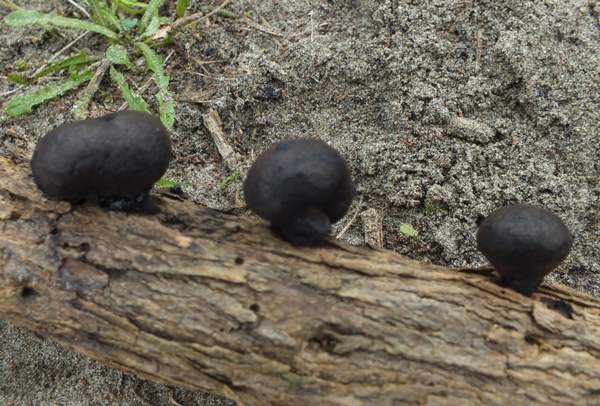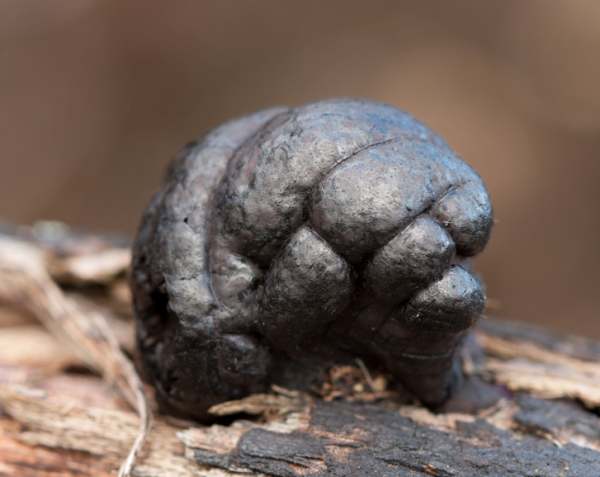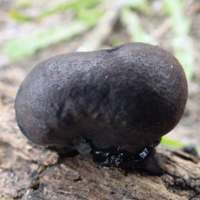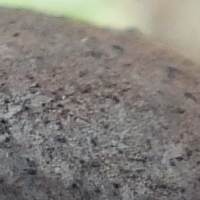Trees Birds Mammals Fish Amphibians Reptiles
Wild Algarve
Bookshop
Daldinia fissa Lloyd
Phylum: Ascomycota - Class: Sordariomycetes - Order: Xylariales - Family: Xylariaceae
Distribution - Taxonomic History - Etymology - Identification - Reference Sources

Whenever you find burnt Gorse, look out for these lumpy, inedible pyrenomycete fruitbodies; they are quite common but easily overlooked against the blackened background of gorse timber..
Initially pinkish brown, these smaller versions of the familiar King Alfred's Cakes Daldinia concentrica go through an asexual stage, during which they release pallid, almost colourless spores known as conidiospores (or simply as conidia), which are pinkish white when seen in mass. Once fully grown the fruitbodies turn black, like those in the picture above. At this mature stage the surface becomes dotted with tiny bumps that are the openings of perithecia, the spore-producing structures located just below the surface. Ascospores, which unlike the pallid conidiospores are jet black, are ejected from these openings in vast numbers, soon covering the surface of the fruitbody and darkening the substrate wood (creating in effect a natural spore print)
for some distance around it.

Distribution
Common and widespread in Britain and Ireland and found throughout most of mainland Europe, this saprobic fungus occurs also in many other temperate countries.
Taxonomic history
Described in 1922 by the American mycologist Curtis Gates Lloyd (1859 - 1926), who named this ascomycete fungus Daldinia fissa, this species had already been described and named (invalidly, it seems) by other mycologists.
Synonyms of Daldinia fissa include Sphaeria vernicosa Schwein., and Daldinia vernicosa (Schwein) Ces. & De Not.
Etymology
The specific epithet fissa comes from the Latin verb fissare meaning to fix securely. It is a reference to the firm attachment of these fruitbodies to their host timber.
Identification guide
 |
Fruitbody
Individual fruitbodies (formally referred to as stroma) of Daldinia fissa are typically 0.8 to 3cm across, growing over several seasons. Initially brown and dense, the fruitbodies
soon turn black, dry out and become less
dense. Each separate fruitbody is attached to the host wood by a
broad, short stalk.
The spore-bearing surface is a series of tiny chambers called perithecia, which are embedded within the outside of the fruitbody, and
ejected spores leave a slightly darker area of wood around the fungus. Each season a new fertile outer layer develops with new perithecia, inside which the next season's ascospores are produced. Large stroma are therefore much older than small ones. |
 |
Perithecia
The picture on the left is a greatly magnified view of a perithecium, the dark chamber within which the asci form and spores are produced. (As with other ascomycete fungi there are infertile paraphyses separating the asci.)
Once the spores inside an ascus have reached maturity, the ascus expands lengthways, guided by the surrounding paraphyses, until its tip extends outside the neck of the perithecium; then water pressure built up inside the ascus bursts open the tip of the ascus and the ascospores are forcibly ejected either singly or in sets of eight at a time. The ascus shrivels leaving the opening clear for the next set of spores to be expelled. |
| |
Spores
Ellipsoidal to fusiform, typically 14x7µm.
Spore print
Black. |
Odour/taste |
Not distinctive. |
Habitat & Ecological role |
Saprobic, on burnt gorse wood (Ulex sp.). |
Season |
Ascospores are produced from late spring
through to the end of autumn, but fruitbodies (stroma) can be seen at any time of year. |
Similar species |
Daldinia concentrica grows mainly on dead Ash timbers and generally produces larger fruitbodies |
Reference Sources
Fascinated by Fungi, 2nd Edition, Pat O'Reilly 2016, reprinted by Coch-y-bonddu Books in 2022.
Dennis, R.W.G. (1981). British Ascomycetes; Lubrecht & Cramer; ISBN: 3768205525.
Breitenbach, J. & Kränzlin, F. (1984). Fungi of Switzerland. Volume 1: Ascomycetes. Verlag Mykologia: Luzern, Switzerland.
Dictionary of the Fungi; Paul M. Kirk, Paul F. Cannon, David W. Minter and J. A. Stalpers; CABI, 2008
Taxonomic history and synonym information on these pages is drawn from many sources but in particular from the British Mycological Society's GB Checklist of Fungi.
Top of page...
Fascinated by Fungi. Back by popular demand, Pat O'Reilly's best-selling 450-page hardback book is available now. The latest second edition was republished with a sparkling new cover design in September 2022 by Coch-y-Bonddu Books. Full details and copies are available from the publisher's online bookshop...